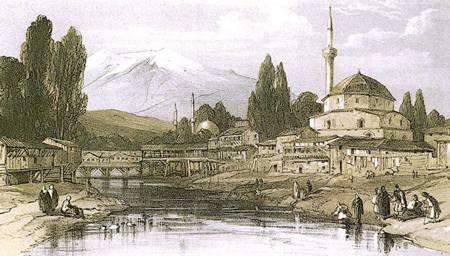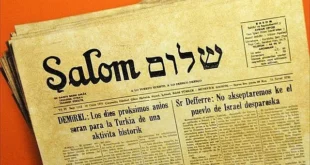On the eve of the German invasion of Yugoslavia, 810 Jewish families – 3,351 people – lived in Monastir (Bitola), a vibrant, ancient Sephardic-Jewish community with a flourishing Zionist movement in the interwar period.
On 11 March 1943 (4 Adar Bet, 5703) the Jews of Monastir, together with the entire Jewish population of Macedonia (some 7,350 people in total), were taken by soldiers, police and Bulgarian officials to Skopje, the capital of Macedonia, where they were held at the local “Monopol” tobacco factory under the most terrible conditions.
After a week-and-a-half, on Shushan Purim, 22 March 1943 (15 Adar Bet), cattle cars left Monastir. Inside was the first transport of Macedonian Jews from “Monopol,” bound for the Treblinka death camp in Poland. In the days that followed, on 25 and 29 March, additional transports departed all for the same destination – Treblinka.
From the 3,276 Jews of Monastir held at “Monopol,” all of them Yugoslav citizens, only five managed to escape. In addition, three Jews were released by the Bulgarians. A number of Jews had fled before 11 March to Greece in the hope of being rescued, but almost all of them died at Auschwitz. A few dozen young Jewish men and women from Monastir joined the partisans and fought in the different units; some of them were killed in battle, few survived.
This is the story of the community of Monastir.
This is the story of a community of many years and a multitude of virtues, a community that did not allow poverty or other troubles to disturb its Jewish traditions, the story of a community that was almost completely destroyed.
Jews expelled from Spain who settled in Monastir found a small Jewish community there. Throughout its existence, Monastir’s Jews maintained ties with other Jewish communities across the Ottoman Empire, with the town’s rabbis gaining particular prominence. The community grew steadily, comprising over 10,000 souls by the beginning of the 20th century; however, most of them emigrated from the town before World War II. Despite the grueling conditions and internal strife, the Jews of Monastir were diligent in their charitable support of one another.
This is the history of a community that once was, and is no longer. These are the stories of the Jews of Monastir.

History of the Community Until the 20th Century
The town of Monastir sat on an ancient road, the Via Egnatia, the shortest land route between the two Imperial Roman capitals, Rome and Constantinople.
During 1381-1382, the Ottomans conquered Monastir, and turned it into a military fortress. Ottoman rule lasted until 1912, and the hundreds of years of Turkish administration left its mark on the Jews of the city.
At the end of the 15th century, Jews expelled from Spain settled in Monastir, where they encountered Romaniotic Jews – Jews that had been living in the area since the times of Ancient Rome. Refugees from the Iberian Peninsula continued to identify with the splendid culture of their countries of origin, and established separate communities in the Balkan cities not just according to their home countries, but also according to the regions whence they originated. They established two communities in Monastir, Aragonese and Portuguese, which for hundreds of years, until the Holocaust, kept separate synagogues, and suffered many disputes between them.
In the 16th century, Monastir contained some 1,500 houses, about 200 belonging to Jewish families. Some 200 years later, according to statistical information from 1889, Monastir had 31,257 residents, of which 5,500 were Jewish. The Jewish community of Monastir was in contact with other communities across the Ottoman Empire, especially that of Saloniki in Greece.
Economic Life
Jews expelled from Spain and Portugal had a command of many languages, and were well versed in the different branches of trade and commerce. As such, they initiated independent trade connections with colleagues across the Ottoman Empire. In the 16th and 17th centuries, most of the Jewish population of Monastir worked in commerce, brokerage and clothing manufacture – wool trimming, spinning, weaving and leather tanning. They were also goldsmiths, tax collectors, butchers, moneylenders, vine-growers, matchmakers and peddlers. Many of them made a living through trade, and often had to travel from place to place, country to country.
Religious Life
Few cities were as blessed as Monastir for its rabbis, dayanim (religious court judges) and chachamim (wise men).
At the end of the 16th century, a fire broke out in Monastir that destroyed the Jewish houses as well as both the Aragonese and Portuguese Synagogues. As a result, the two communities decided to establish a joint fund in order to rebuild one synagogue – they did not have enough money for both – in which they would all pray, and when finances improved, a Beit Midrash (study hall). In order to decide what would be built first a lot was cast, and the Aragonese synagogue was chosen. The two communities shared the premises for a while, but from time-to-time, frictions arose. As the Beit Midrash that was supposed to be assembled on the Portuguese lot was never built, the Portuguese community asked for help from the Aragonese community to build their own synagogue, but the response was negative. However, the period remained mainly one of calm and reconciliation between the two communities.
In the 17th century, the Jews of Monastir were too populous to be housed in the available synagogues, and non-Muslims were forbidden from building new prayer houses. Thus the community was forced to compromise, and in January 1643 began to rent extra space on a daily basis. The use of private homes for prayer services became customary for many generations.

History of the Community Until 1941
The Emigration Movement
In the first decade of the 20th century, there were some 11,000 Jews in Monastir, about one sixth of the local population. However, from the beginning of the century, the community suffered from economic distress and overcrowding, and many chose to emigrate, some remaining within Yugoslavia, and others across the ocean to the US, Chile, Israel and Greece – mainly Saloniki.
Rabbis
In 1913, with the annexation of the city to Serbia, a young rabbi from Jerusalem was invited to Monastir. Rabbi Dr. Ariel Ben-Zion, whose family had been exiled from Spain, had completed his scientific studies in Germany, and his arrival blessed the community with the leadership of one of the principal figures in Sephardic Jewry.
After the First World War, Yitzhak Elisafan, a notable teacher and cantor in Monastir, established Lomdei Torah, an educational-halachic institution for youth. Lomdei Torah staged Zionist-Nationalist performances in Hebrew written by Elizafan, and on Jewish holidays, its students would parade in the streets of the city, dressed in cloaks and hats, singing Hebrew songs. Elizafan emigrated to Eretz Israel in 1932.
In 1924, Rabbi Shabtai Ben Yosef Djaen was appointed chief rabbi of the community. Rabbi Jain strongly encouraged his flock towards Zionism. Some of his actions were considered revolutionary; for example, the removal of the iron screens from the synagogue’s women’s section, and the bringing in of female teachers and kindergarten staff from Eretz Israel. Rabbi Djaen also established a food kitchen for the needy, and when he saw that the locals were using tombstones from the Jewish cemetery for building material, he collected enough funds to erect an iron fence around the cemetery, ornamented with Stars of David. Rabbi Jain served until 1928, when the World Organization of Sephardic Jewry sent him to South America.
Rabbi Avraham Ben Moshe Romano, the last chief rabbi of Monastir, arrived in the city in 1931. Rabbi Romano made great endeavors on behalf of the community, which by then was in a dangerously low economic and social situation due to the unrest in the Balkans – destructive wars, changes in government and economic distress that caused 1,090 Jews to emigrate from Monastir in the 1930s. In March 1943, Rabbi Romano was deported with his community to Treblinka, where he was murdered.
Synagogues
The two synagogues – Il Cal Di Aragaon and Il Cal Di Portugal – were not large enough to accommodate the number of congregants. Over the years more prayer houses were built or spaces were cleared in private homes, mostly as a result of donations by members of the community. Among these were the Shlomo Levy Synagogue, the Ozer Dalim Synagogue, and more.
Education
In the interwar period, education in Monastir was similar to that practiced in other cities across the country, with 12 grades in state schools, of which four were elementary and eight high school. At the time, only a few families could afford to send their children to high school, and at the age of 10 most children left the educational framework to help support their families: the boys as apprentices to craftsmen, and the girls as laundresses and housekeepers. In 1924, the first female kindergarten teacher from Eretz Israel, Leah Ben David, arrived in Monastir to help prepare the children for aliya (emigration to Eretz Israel).
Thus in the 1935-1936 school year, 625 Jewish children studied in the elementary schools, and 13 at the vocational girls’ school. At the end of the year, of the 625 elementary school children, only 20 signed up for high school.
In the 1939-1940 school year, a government decree was enacted to limit the number of Jewish children at state schools. As a result, 25 Jewish students were removed from school.
Life in the Jewish Quarter

The Jews of Monastir lived along the Dragor River in a quarter without a surrounding wall. The quarter was divided into areas: La Bustanico, La Tavana, La Bomba, Los Corttijos, Ciftlik, and more. The first two alluded to the professions of the residents – fruit-growers in the first, and in the second, tanners. Los Cortizhos (the courtyards) comprised one large courtyard surrounded by a continuous row of attached houses, each with its own small courtyard. Above almost every front door was a Hebrew inscription or the Hebrew year in which the house was built. Near the Jewish quarter was an area called Hachiptalik (the farm), where underprivileged Jews lived in gloomy, neglected shacks.
Ver más fotografías
Charity and Aid Organizations
Over the generations, charity and aid organizations were established in Monastir to help the needy of the community as well as in Israel.
In 1894, the “Ozer Dalim” organization was set up, with each member paying membership according to his or her ability. The poorer members made especially sure to pay their dues, so as not to lose their membership. When any member of the organization or his family fell sick, a doctor was ordered, medicines and foodstuffs were bought and, when necessary, hospitalization was paid for. In cases of serious illness, patients were sent to hospitals in Belgrade and Vienna. The Arueti family established a synagogue by the same name, whose congregants were all members of the organization.
On Passover and the Jewish New Year, the “Malbish Arumim” organization, supported by the Jews of the town and emigrants to the US, provided clothing and shoes to destitute children.
The American Fund, set up by ex-Monastir residents in the US, was run by people chosen by the community. In 1924, the Fund bought equipment for the school and distributed it among needy children. Every day, the “Matanot LaEvyonim” organization (Minza Di Alivos Povris) provided some 200 orphans with a hot, meat meal. The Burial Society took care of the final respect paid to the deceased, and also contributed money to the community itself. The Jewish Women’s organization helped poor brides in particular, and Jewish professionals took care of protecting the rights of the less educated vis-à-vis city and state institutions. The town also had a branch of WIZO.
All these organizations operated until the German invasion in April 1941.
Fuente: Yad Vashem
 eSefarad Noticias del Mundo Sefaradi
eSefarad Noticias del Mundo Sefaradi

